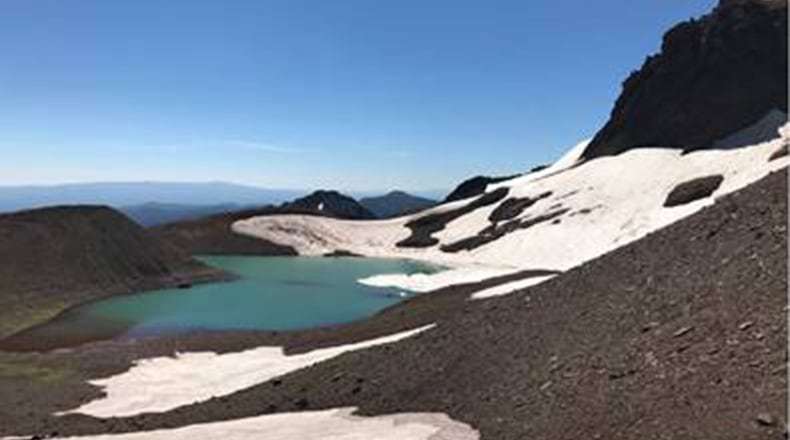For a lake with no name, a lot of people sure know about it.
It should come as no surprise that the Broken Top Trailhead, a starting point to No Name Lake, is mentioned prominently in the U.S. Forest Service’s Central Cascades Wilderness Strategies Project, which could soon lead to limited use via a permit system in certain high-use areas of the Three Sisters Wilderness. Over the past five years, visits to the Three Sisters Wilderness have increased by 200 percent, according to the project, and Broken Top Trailhead is one of the most frequently used trailheads.
No Name Lake, at 8,150 feet, is no secret, and I won’t pretend it is here. But for some reason, I had yet to make the hike to the lake until last week.
Maybe that was because the roads to reach the trailhead are so rough. From Todd Lake (23 miles southwest of Bend), a 6-mile drive along bumpy, rocky, sketchy Road 370 and Road 380 is required to reach the trailhead. (For a longer hike, start from Todd Lake, or ride a mountain bike along the roads to the trailhead and stash the bikes there before hiking.) A high-clearance, four-wheel- or all-wheel-drive vehicle is necessary to make the drive.
My Kia Sorento ended up a bit bruised and battered, but it got two hiking buddies and me to the trailhead.
The trail started out through the trees but quickly rose above the tree line. At the first junction, we made a right turn to continue along Little Crater Creek toward the lake. A left turn there leads to Green Lakes, another high-use area of the wilderness.
We searched for the safest route to cross the creek atop some rocks and made it across without getting wet. From there, the trail ascended steeply past Ball Butte with no shade — do not forget the sunscreen for this hike.
Wildflowers of a variety of colors — but most distinctively the red Indian paintbrush — lined the creek along our route toward the lake. Small waterfalls trickled here and there as snowmelt filled the babbling brook.
Eventually, we reached some snowfields that we crossed relatively easily. After the last snowfield along the trail, the path continued up through a rocky shale area just below the lake. There, hikers should use caution as loose rock and sand can make for difficult traction on the approach to the lake.
Once we crested the final ridge, we were treated to quite a memorable sight: No Name Lake — with a few chunks of ice still floating in it — sitting at the base of snowy, castlelike Broken Top.
Hikers’ reactions when they reach the lake are comical to hear. Many of them call out in awe at the shockingly scenic site, giving credence to the Forest Service’s plan to further protect the special area by limiting use. Enjoying the lake with five hikers around you is a different experience from enjoying it with 30 to 40 others.
Once at the lake we continued along a trail that led to the right and skirted the east shore. A few tents here and there showed how the lake is also a popular overnight camping spot for hardy backpackers.
At the north end of the lake the trail continued up a steep slope to the top of a ridge. We topped the ridge in about 10 minutes and were treated to dramatic views of South, Middle and North Sister and more snowy slopes of Broken Top.
After eating our sack lunches and chatting with several other hikers atop the ridge, we made our way back down for the relatively fast descent to the trailhead.
The 6-mile hike included about 1,200 feet of elevation gain and required about three hours. But plan for longer to linger at the lake, a gem of the Central Oregon Cascades that should not be missed — and has not been missed by many.
About the Author
